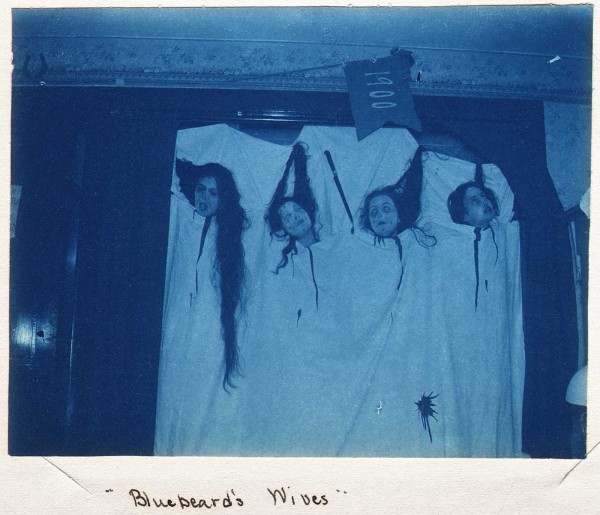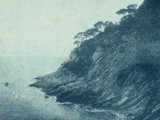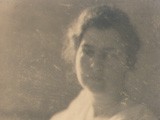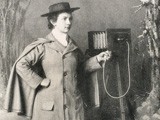Bluebeard's Wives
Photographer Unknown
CountryUnited States
MediumCyanotype
PortfolioSmith College Album 1897-1900
Year1900
View Additional Information & Tags
Allegorical, Costume Study, Death, Flashlight photograph, Spirit Photograph
Dimensions
Image Dimensions: 7.4 x 9.6 cm
Support Dimensions: 18.2 x 27.5 cm thin, manilla album leaf
Associated Blog Posts:
During a Halloween party in Northampton, Massachusetts, Smith College students have some ghoulish fun portraying themselves as some of the decapitated wives done in by the hand of a French nobleman. This villain, known as Bluebeard, comes from the European folktale “Barbe bleue” first made famous by author Charles Perrault in 1697. Wikipedia says Bluebeard “tells the story of a wealthy violent man in the habit of murdering his wives and the attempts of one wife to avoid the fate of her predecessors. “The White Dove”, “The Robber Bridegroom” and “Fitcher’s Bird” (also called “Fowler’s Fowl”) are tales similar to “Bluebeard”.
Short History of the first Tenney House
March 23, 1895, Mrs. Mary Smith Tenney (1813-1895-editor) died, leaving her homestead to the college. Through her influence an undivided half of the estate had been bequeathed to the college by her brother, Justin Smith, who died in 1880, on condition that his sister should have the use of it during her life. Mrs. Tenney was a native of Northampton, and much esteemed by those who knew her for her rare qualities of mind and heart. In her early life she was one of the pioneer teachers in the West, and after her marriage conducted successfully, with her husband, Dr. Tenney, a famous school in Ohio for a quarter of a century. She then returned to her birthplace, and, after Smith College was founded, became deeply interested in its welfare. For several years she made her house a home for its students, and bequeathed it to the trustees with the intention, as stated in her will, “to provide a home for the students of Smith College which shall be called the Mary Smith Tenney House, as a memorial of my interest in the higher education of women. It is my desire that thereby students who are unable to meet the full expense of a college education may obtain board at lower rates. At the same time, I do not desire that the house be exclusively for this class, but also for other students who may be able to pay the current prices, so that the same spirit of social equality may prevail as in the other college houses.” The house, thus given to the college, was built by Mrs. Tenney’s great-grandfather, Isaac Clark, in 1710, when the outskirts of Northampton were a wilderness, and Indians were the terror of the inhabitants, and wild beasts frequently came to their doors. It was occupied by four generations of the same family for nearly two hundred years. (1.)
Current Tenney House: 156 Elm Street, Northampton
From the Smith College website:
Tenney is at the corner of Paradise Road and Elm Street, in front of the president’s house. Traditionally, it has a long waiting list as it is the only vegetarian cooperative-living house on campus.
Print notes, recto: cyanotype loosely inserted within thin, manila album leaf and titled in black ink on lower margin of support: Halloween, Tenney House. One of two photographs on this leaf, the other titled Hebe & Bacchus.
Provenance: acquired by this archive in 2017; from larger disassembled album with direct ties to Mary Ruth Perkins, 1878-1975; Smith College class of 1900 graduate and Chairman of the class yearbook committee that year.
1. History of Tenney House: Celebration of the Quarter-centenary of Smith College: October Second and Third; 1900: Cambridge: printed at the Riverside Press, pp. 117-18. This first home, demolished in 1937, was located at 33 Elm Street in Northampton, the current location for the Smith College Alumnae Association building.




